Harissa (North African Chili Paste)
This post may contain affiliate links. See my disclosure policy.
Harissa is a famous and versatile North African red chili paste that will add incredible flavor, color, and kick to your food! It’s easy to make and keeps for several weeks in the fridge!
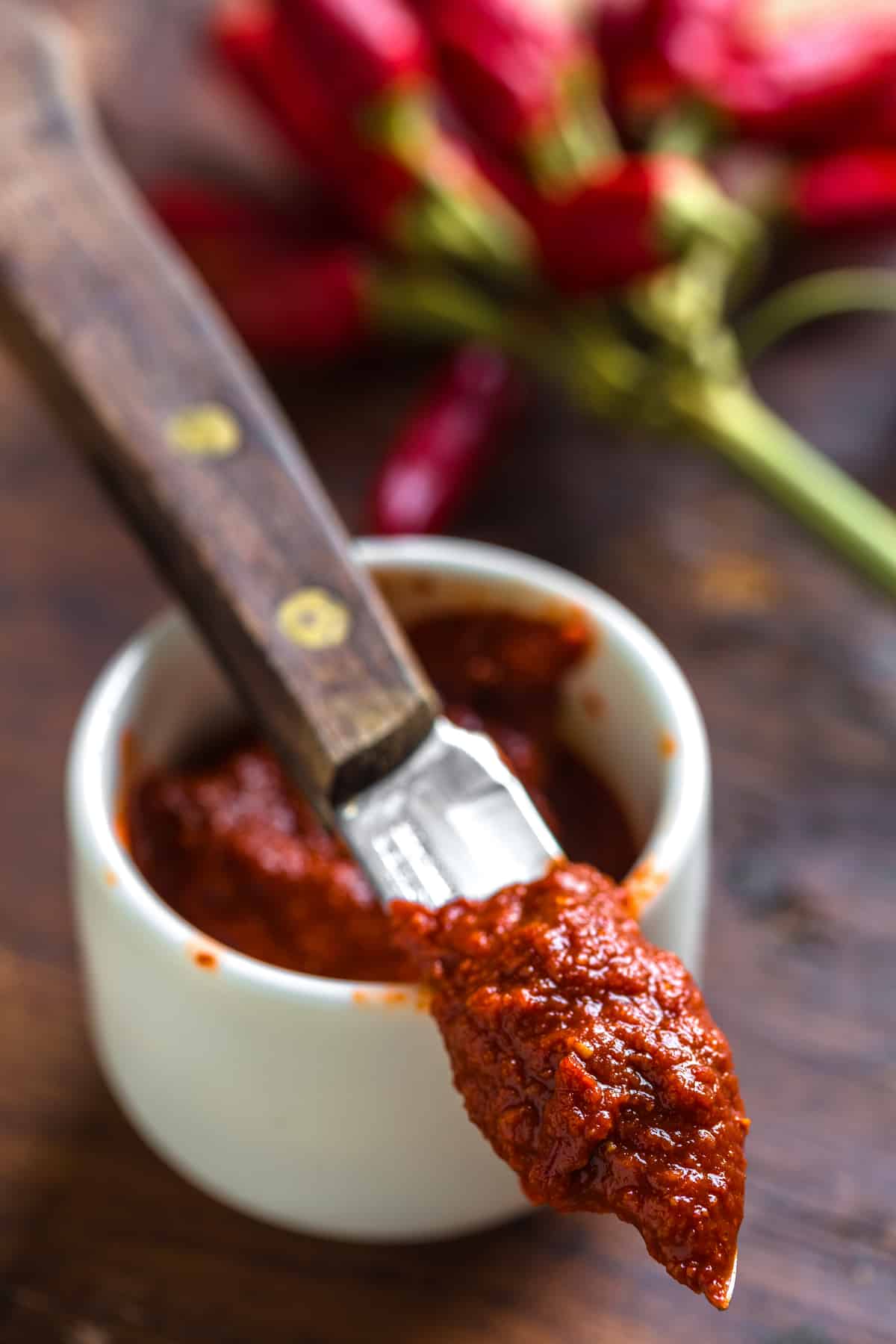
What is Harissa?
Harissa is a fiery North African chili paste that is popular in Tunisian and Algerian cuisine but is perhaps most commonly associated with Moroccan food. This harissa recipe is easy to make. It’s made up of dried chiles, olive oil, garlic and spices. The dried chilies are reconstituted in boiling water, the whole spices are toasted and ground, and everything is pulsed in a food processor or blender (or use a mortar and pestle) until a chunky paste is formed.
Once you’ve made your own you’ll never use store-bought again. The flavor of homemade harissa is much bolder and vibrant than any commercially made product. Whip up a batch in minutes, keep it in your fridge and use it whenever you want to add flavor, color and kick to your food!
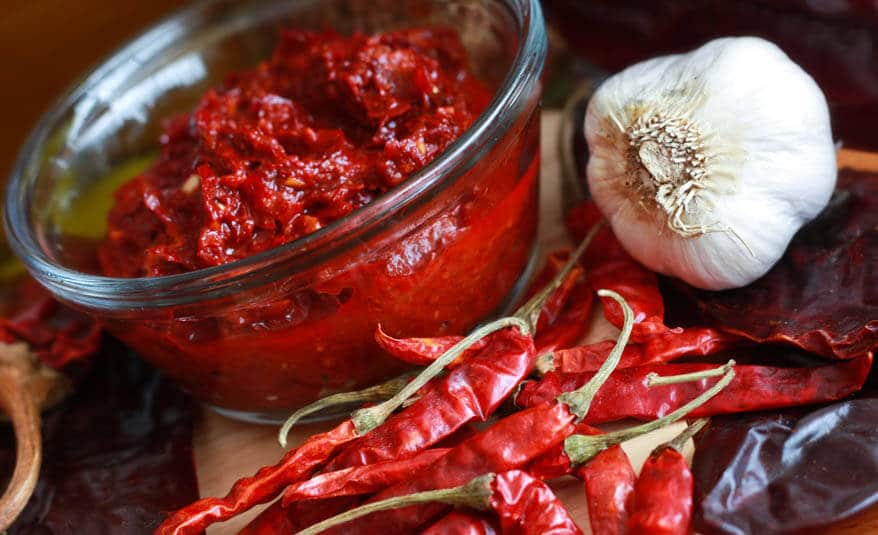
Harissa Recipe
Let’s get started!
You can use a variety of red chili peppers, it’s your choice. New Mexico and Guajillo chilies work well. I use and recommend this brand or freshness and flavor.
Note: If you don’t want the harissa to be scorchingly hot, cut open the dried chilies and remove the seeds and membranes. (It’s always advised to use gloves for this.) Put the dried chilies in a bowl.

Pour boiling water over the dried chilies and let them sit for 20 minutes.
While the chilies are soaking heat a small skillet over medium heat and toast the caraway, coriander, and cumin seeds, frequently stirring them, until very fragrant, about 4-5 minutes. Be careful not to scorch them or they will be bitter. Let the spices cool completely and then transfer them to a spice or coffee grinder and grind them to a fine powder. I’ve been using my KRUPS coffee/spice grinder for over 10 years and it’s still going strong.
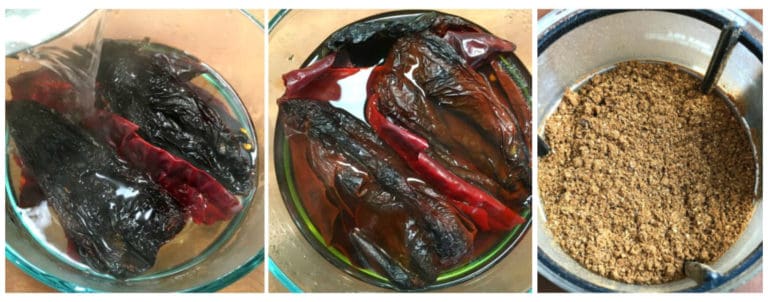
Drain and squeeze the chiles to release as much liquid as you can. Add them to a food processor along with the ground spices, olive oil, garlic, salt, and lemon juice. Process to a smooth paste. Add more olive oil if it’s too dry.
Transfer the paste to a glass jar and pour some extra olive oil on top, about 1/4 inch in depth. After each use, top it off with olive oil. Store in the fridge where it will keep for about 3 weeks.
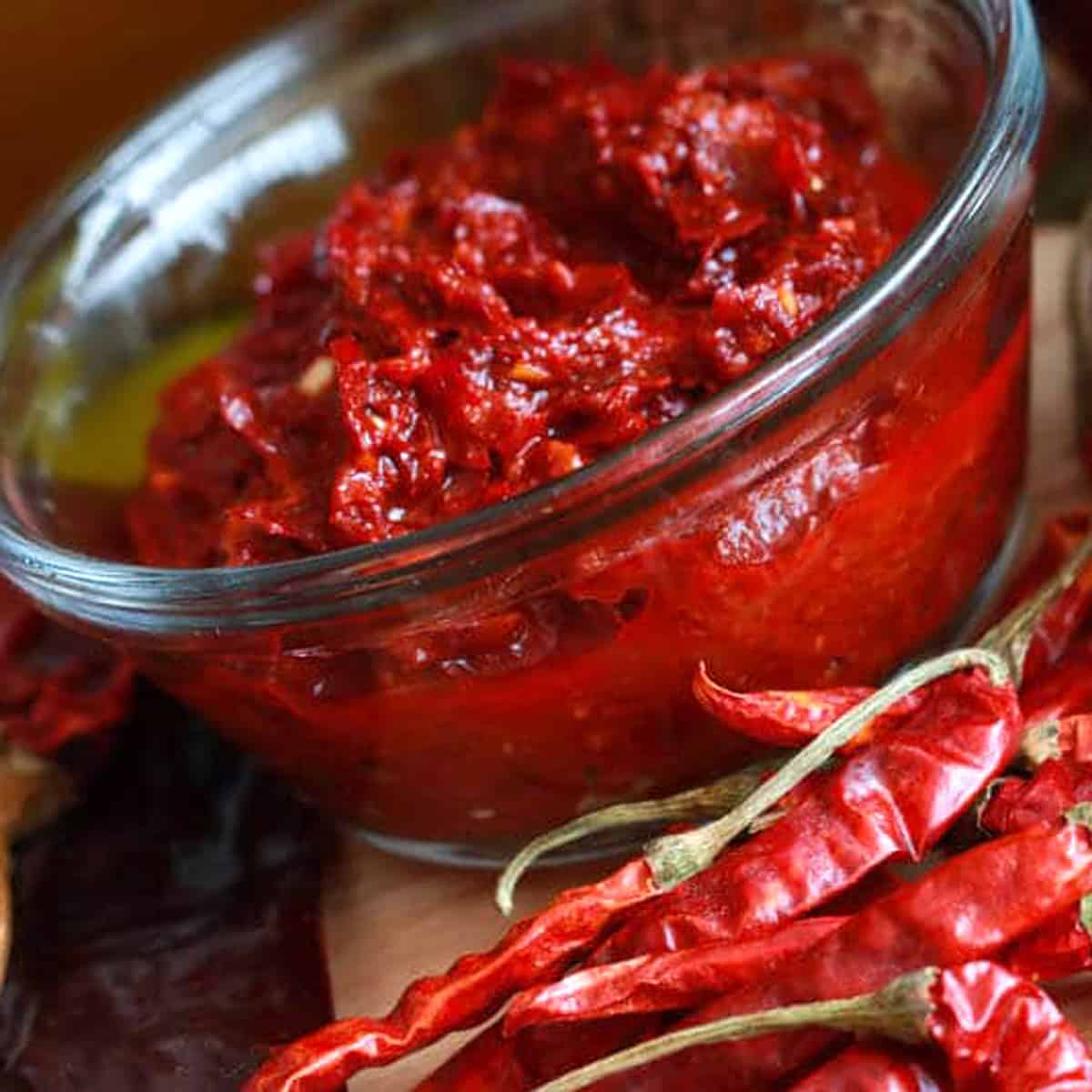
How To Use Harissa
The sky’s the limit for this versatile sauce but here are a few ideas to get your started:
- Burgers – mix it into the burger meat or swirl it into your mayonnaise or ketchup. Try it in our Moroccan Veggie Burgers!
- Fry Sauce – stir it into your mayonnaise for a kickin’ Fry Sauce for dipping!
- Sandwiches
- Gyros
- Marinade or Rub – it’s perfect for meat, poultry and fish.
- Fish Tacos
- Sauces & Stews – a little goes a long way to adding a terrific depth of flavor with a touch of heat. Try it in our fabulous Moroccan Harira or Chicken Tagine!
- Roasted Vegetables – toss your veggies with some harissa before roasting them in the oven.
- Yogurt Sauce/Dressing – a spicy and refreshing sauce for grilled meats and for salads. You can also add a spoonful to your potato and pasta salads or Moroccan Chicken Salad for a spicy touch.
- Salad Dressing – a touch of this is great in your vinaigrettes too.
- Hummus – stir a little harissa into your Hummus for additional flavor and some kick!
- Pasta – add some to your tomato sauce.
- Pizza – add some to your pizza sauce.
- Eggs – if you’re a fan of adding Tabasco sauce to your eggs, just wait until you try this!
Enjoy!
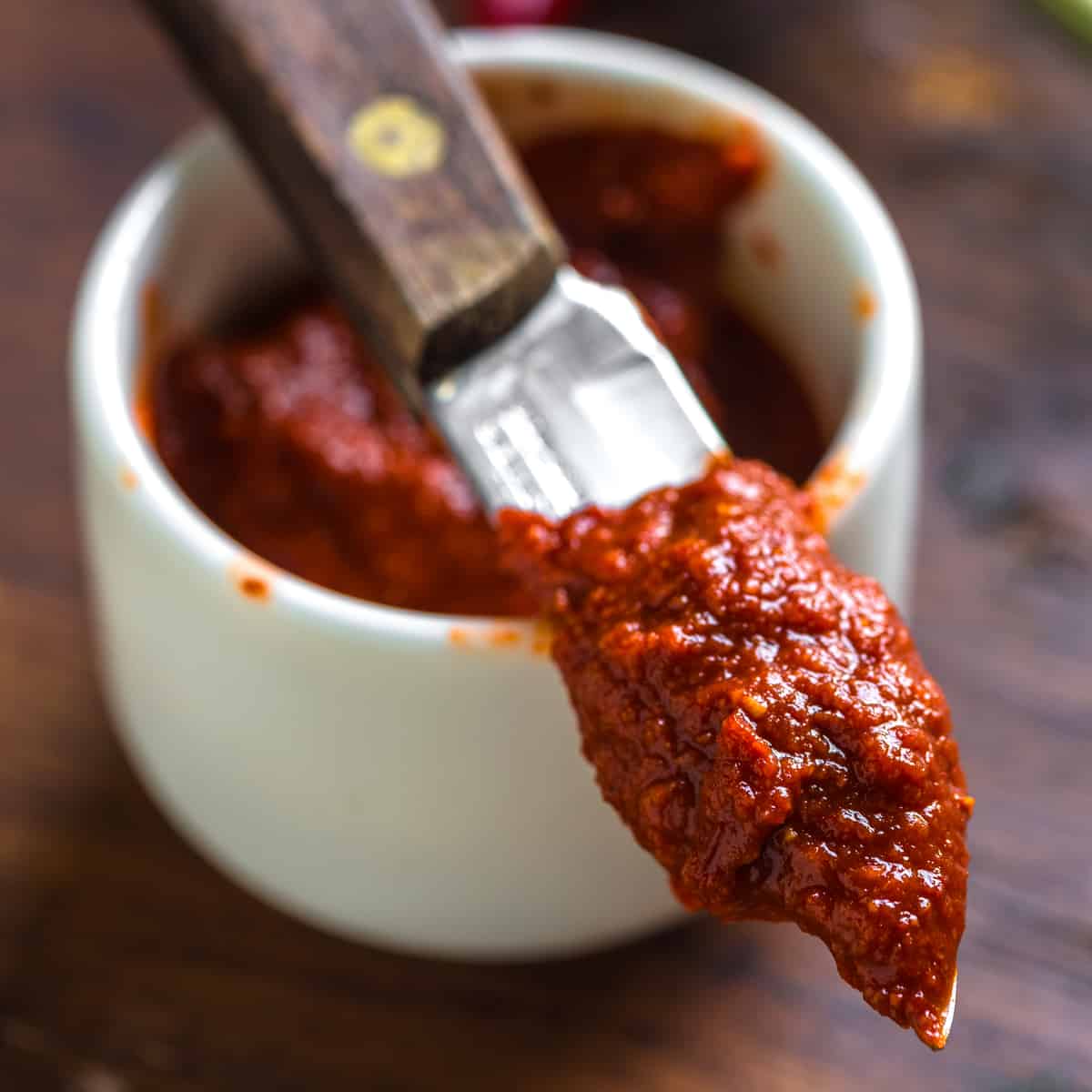
For more homemade condiments from around the world try my:
- Romesco Sauce
- Big Mac Sauce
- Ponzu Sauce
- BBQ Sauce Recipe
- Tartar Sauce
- Teriyaki Sauce
- Sweet Chili Sauce
- Sweet and Sour Sauce
- Homemade Ketchup
- Romesco Sauce
- Hoisin Sauce
- Black Bean Sauce
- Mignonette Sauce
- Adobo Sauce
- Yum Yum Sauce
- Tahini
- Eel Sauce
- Tzatziki Sauce
- Curry Ketchup
- Kecap Manis
Save This Recipe
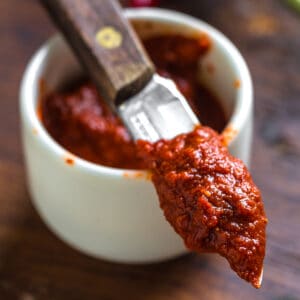
Harissa (North African Chili Paste)
Equipment
- mini food processor (I love this mini one for small quantities)
Ingredients
- 16 dried red chilies (New Mexico and guajillo chilies work well, remove seeds, membranes and stems. If you want a really hot paste, leave the membranes)
- 1/4 teaspoon caraway seeds
- 1 teaspoon cumin seeds
- 1 teaspoon coriander seeds
- 3 tablespoons extra-virgin olive oil
- 1/2 teaspoon kosher salt
- 3 cloves garlic
- 2 tablespoons freshly squeezed lemon juice
Instructions
- Put the dried chiles in a bowl and cover with boiling water. Let them sit for 20 minutes. Heat a small skillet over medium heat and dry roast the caraway, coriander, and cumin seeds, frequently stirring them, until very fragrant, about 4-5 minutes. Let them cool completely and then transfer them to a spice or coffee grinder (or mortar and pestle) and grind them to a fine powder.
- Next, drain and squeeze the chiles to release as much liquid as you can. Add them to a food processor along with the ground spices, olive oil, garlic, salt, and lemon juice. Process to a smooth paste. Add more olive oil if it’s too dry. Transfer the paste to a glass jar and pour some extra olive oil on top, about 1/4 inch in depth. After each use, top it off with olive oil. Keep refrigerated. Will keep for about 3 weeks.Makes about 1 cup.
Nutrition
Originally published on The Daring Gourmet April 26, 2015



















My husband cannot eat bell peppers so this recipe was perfect for him. We do not have NM chiles available to us where we live so used dried Arbil and guajillo. Thanks for the hint to squeeze the water from the rehydration of the dried peppers. I made a sauce last month that said to use the rehydration water in the sauce and it overpowered the pepper flavor with bitterness. Thank you for this spicy and tasty reciple
Fantastic, Janet, I’m so glad you enjoyed it, thank you very much!
How to use fresh chillies instead of dried? thanks filomena, Brazil
If we wanted to tone down the heat, would ancho peppers work? Maybe a combo of ancho and guajilo. Thanks for your input. I love your articles.
Hi Robin, yes you can either or a combo of those. Thank you and happy cooking! :)
I followed this recipe exactly (not something I usually do) and it is just perfect. Thank you!
In comparison to jalapeno, how hot are the guajillo chilies? (no seed, just the pepper itself)
Look forward to making this!
Kimberly, I really enjoy your recipes and your writing!….makes me laugh :)
Hi Patricia, they’re quite a bit milder. Jalapenos have a Scoville heat unit of 8000 whereas guajillos are 5000. Guajillos have a great flavor and if you want your harissa hot you can leave the membranes in (that’s where most of the heat is) and add some hotter variety of peppers along with it.
Thanks, Kimberly! Btw, I also really enjoy the culinary/ingredient history in your writing content, so interesting! And love your humor as well :) Look forward to making several of your recipes, including preserved lemons.
Thanks, Patricia! I occasionally get hate mail over that very same thing, lol (“I don’t need a history lesson, just give me the $@!& recipe!!”) but it doesn’t stop me from writing about the things I find fascinating – I’m glad you enjoy them as well! :)
Could you use cayenne peppers in this? I grow and dry them myself. Ended up with a bumper crop this year. Would love to put them to use in this recipe. Thank you!
Absolutely, Amy!
I love the step by step photos! It really helped in make this paste!
I made this for our bbq and it was super delicious on top of my hamburger! Great idea!